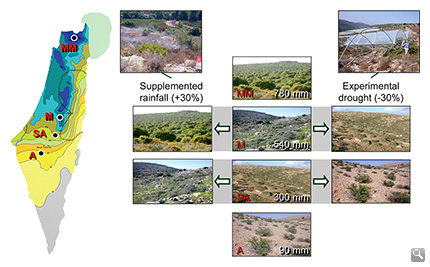Phenotypic and genetic variation in Biscutella didyma and adaptation to environmental change - a combined ecological-genomic approach
Project code: TI 338/11-1

Adult Biscutella didyma plant grown in the greenhouse
Local adaptation and geographic separation are crucial for the evolution of diversity, and recent whole-genome analyses in humans have revealed evidence for spatial distribution of genetic differences. The forces shaping these patterns are, however, only understood in few cases, because it is generally not known how genetic differentiation arises in the first place. Top-down approaches can point to regions of the genome under selection in the recent past, but they rarely identify the responsible genes and the selected traits. Conversely, ecological studies on local adaptation have made little use of the progress in genomics. Here, we combine modern evolutionary ecology with state-of-the art genomics to study real-time evolution in Biscutella didyma. We utilize a unique field experiment to test genome-wide differentiation along an aridity gradient, study whether genome-wide signatures of selection are detectable in populations that have been exposed to manipulated precipitation regimes, and whether phenotypic variability in response to selection gradients corresponds to theoretical predictions. Our findings will enable us to develop models of adaptive capacity of this species under predicted climate change. We will also test models of life history evolution against realistic scenarios of genetic structure and its interaction with stabilizing and balancing selection.
Experimental set-up in Israel. Plats are grown at various sites with different amounts of rainfall per year. Experimental sites are indicated as black dots in the map, different colors distinguish the different amounts of rainfall per year. MM mesic Mediterranean, M Mediterranean, SA semi-arid, A arid condition.
Publications related to the project
- Tielbörger K, Bilton MC, Metz J, Kigel J, Holzapfel C, Lebrija-Trejos E, Konsens I, Parag HA, Sternberg M Middle-Eastern plant communities tolerate 9 years of drought in a multi-site climate manipulation experiment Nature Communications 5, Article number: 5102 (2014).

- Metz, J., Ribbers, K., Tielbörger, K., & Müller, C. (2014) Long- and medium-term effects of aridity on the chemical defence of a widespread Brassicaceae in the Mediterranean. Environmental and Experimental Botany 105C: 39-45.

- Tielbörger, K & Salguero-Gomez, R. (2013) Some like it hot: Are desert plants indifferent to climate change? Progress in Botany 75: 377-400.

- Salguero-Gómez R, Siewert W, Casper BB, Tielbörger K. (2012) A demographic approach to study effects of climate change in desert plants. Philos Trans R Soc Lond B Biol Sci. 2012 Nov 19;367(1606):3100-14.


- Ossowski, S., Schneeberger, K., Clark, R. M., Lanz, C., and Weigel, D. (2008) Sequencing of natural strains of Arabidopsis thaliana with short reads. Genome Res 18, 2024-2033.


- Petru, M., Tielbörger, K., Belkin, R. & Sternberg, M., and Jeltsch, F. (2006) Life history variation of an annual plant under two opposing selective forces along a steep climatic gradient. Ecography 29 , 66-74.





